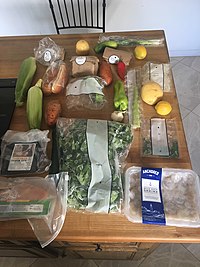
Photo from wikipedia
Research on eating behaviour has confirmed that portion size can substantially influence intake, a phenomenon known as the Portion-Size-Effect (PSE). Despite extensive research interest, there is limited understanding about the… Click to show full abstract
Research on eating behaviour has confirmed that portion size can substantially influence intake, a phenomenon known as the Portion-Size-Effect (PSE). Despite extensive research interest, there is limited understanding about the PSE on intended consumption (often measured by Expected Intake). It also remains unclear whether the presentation of food cues (e.g., Word Descriptors; Food Images) can modulate PSE during pre-meal planning. The current study addressed these questions by comparing PSE on intended versus actual consumption, with 62 participants based on a within-subject design. Participants firstly rated Expected Intake for a pasta dish of three sizes (400, 600, and 800 g), with each size presented in three different formats of food cues. The participants' actual pasta intake with the three portion sizes was tested in three ad libitum sessions over 7 weeks. The results suggested that Expected Intake increases as portion size becomes larger, following a nearly linear relationship. In comparison, the Actual Intake had a smaller increment after the presented portion size exceeded the 'appropriate' range. Relating to these results, the pre-meal PSE was found to be comparable to the actual PSE with moderate portion sizes (i.e., 600 g-400 g), but significantly stronger than the actual effect with large portion sizes. Overall, our data support the hypothesis that portion size can have a stronger influence on meal planning than actual food intake, and show that the format of food cues has considerable influence on Expected Intake. Studies of pre-meal planning should carefully consider the role of portion sizes and food cues on Expected Intake.
Journal Title: Appetite
Year Published: 2019
Link to full text (if available)
Share on Social Media: Sign Up to like & get
recommendations!